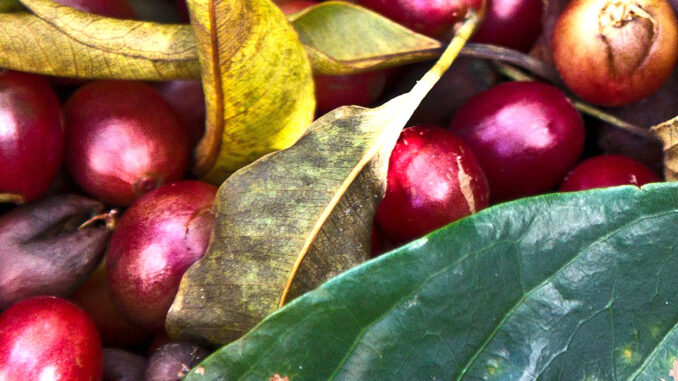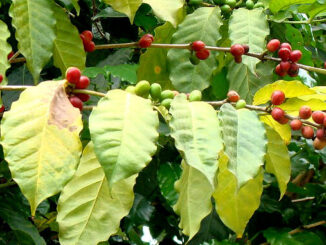
Coffee comes from a tropical evergreen shrub known as the Coffea plant — a remarkable species that produces the beans behind one of the world’s most loved drinks.
From its origins in the highlands of Africa to plantations across the globe, the Coffea plant is both botanically fascinating and culturally significant.
Let’s explore what makes this plant so unique — from how it grows to how it gives us that perfect cup of coffee.
🌿 The Origins of the Coffea Plant
The Coffea plant is native to tropical Africa, particularly Ethiopia, where wild coffee trees still grow naturally.
From there, it spread to Yemen and later to Asia and the Americas, becoming a cornerstone of agricultural and cultural life across continents.
Coffee thrives in the “Coffee Belt” — the tropical zone between the Tropics of Cancer and Capricorn — where the conditions are ideal for growth:
- Stable temperatures between 15°C–25°C (59°F–77°F)
- Moderate rainfall and humidity
- High altitudes (600–2000 meters above sea level)
- Rich, well-drained volcanic soils
🌱 Description of the Coffea Plant
The Coffea plant is part of the Rubiaceae family, which also includes gardenias and quinine trees.
It’s an evergreen shrub or small tree, growing anywhere from 1.5 to 10 meters tall, depending on cultivation and pruning.
Main features of the plant:
- Leaves: Glossy, dark green, and oval-shaped
- Flowers: Small, white, and fragrant — they bloom for only a few days
- Fruit (Cherry): A small red or purple berry containing two coffee seeds (the “beans”)
- Seeds (Coffee Beans): Green when raw, they turn brown during roasting
Each tree can yield between 1 to 1.5 kilograms (2–3 pounds) of green coffee beans per year.
☕ The Coffee Cherry and Its Layers
Each coffee cherry is made up of several layers that protect and shape the flavor of the bean inside:
- Skin (Exocarp): The thin red outer layer
- Pulp (Mesocarp): The sweet, fruity flesh
- Mucilage: A sticky layer rich in sugars
- Parchment (Endocarp): The protective paper-like shell
- Silverskin: A thin membrane covering the bean
- Bean (Seed): The part that’s roasted and brewed into coffee
Sometimes, a cherry produces only one bean instead of two — this is called a peaberry, and it’s considered rare and special due to its concentrated flavor.
🌍 Main Species of Coffea
There are over 120 known species of the Coffea plant, but only a few are cultivated for commercial coffee production.
The most common are:
1. Coffea arabica (Arabica)
- Origin: Ethiopia and South Sudan
- Grown at high altitudes (1,000–2,000 m)
- Flavor: Sweet, smooth, and aromatic
- Acidity: Bright and pleasant
- Accounts for about 60–70% of global coffee production
Arabica coffee is prized for its refined flavor and aromatic complexity, making it the favorite of specialty roasters worldwide.
2. Coffea canephora (Robusta)
- Origin: Central and West Africa
- Grown at lower altitudes (200–800 m)
- Flavor: Strong, earthy, with higher bitterness
- Caffeine content: Almost double that of Arabica
- Accounts for about 30–40% of global production
Robusta is commonly used in espresso blends, providing crema, strength, and boldness.
3. Coffea liberica (Liberica)
- Origin: West Africa
- Flavor: Floral, fruity, and woody
- Bean shape: Larger and asymmetrical
- Represents less than 2% of global production
Liberica coffee is rare but distinctive — often used in Southeast Asia for its complex and aromatic taste.
4. Coffea excelsa (Dewevrei)
- Technically a variety of Liberica
- Adds tart, fruity, and spicy notes when blended
- Grown mainly in Southeast Asia
Excelsa adds depth and brightness to blends, enhancing aroma and acidity.
🌸 The Life Cycle of a Coffee Plant
The Coffea plant follows a slow but steady growth cycle that can last decades.
Stage 1: Germination
Seeds sprout within 2–3 months after planting.
Stage 2: Growth
In the first 2–4 years, the plant matures, producing leaves and branches.
Stage 3: Flowering and Fruiting
Once mature, it blooms with white flowers and produces coffee cherries that ripen in 6–9 months.
Stage 4: Harvesting
Coffee cherries are handpicked or mechanically harvested once they turn bright red.
Stage 5: Production Lifespan
A healthy coffee tree can produce quality fruit for 20–30 years — sometimes even longer under good care.
🌳 Where the Coffea Plant Grows Best
The Coffea plant flourishes in tropical regions known for their stable climates and fertile soil.
The main producing areas include:
- Latin America: Brazil, Colombia, Costa Rica, Guatemala
- Africa: Ethiopia, Kenya, Tanzania
- Asia: Vietnam, Indonesia, India
Each region contributes unique flavor characteristics — from Ethiopian floral notes to Brazilian nutty sweetness.
☕ From Plant to Cup
After harvesting, coffee cherries go through processing (wet, dry, or honey method), drying, hulling, roasting, and grinding before becoming the drink we love.
Every step influences the flavor — but it all begins with the Coffea plant.
Without this remarkable shrub, there would be no espresso, no cappuccino, no morning ritual — just a world far less aromatic.
❤️ Final Thoughts
The Coffea plant is nature’s gift that fuels millions of people every day.
It’s a living organism with deep cultural roots and global impact — connecting farmers, roasters, and drinkers across continents.
From its delicate white flowers to its bold, roasted aroma, every stage of its life is a testament to how something small and green can bring so much joy to the world.
☕ One plant, endless possibilities.
DeliciousPath: Enjoyment in Every Moment
Explore the Gourmet on Board category for exquisite flavors that elevate your meals, even when you’re on a boat, and the Coffee category for aromatic coffee blends that make every moment special. DeliciousPath is here to turn every experience into something unforgettable!

























